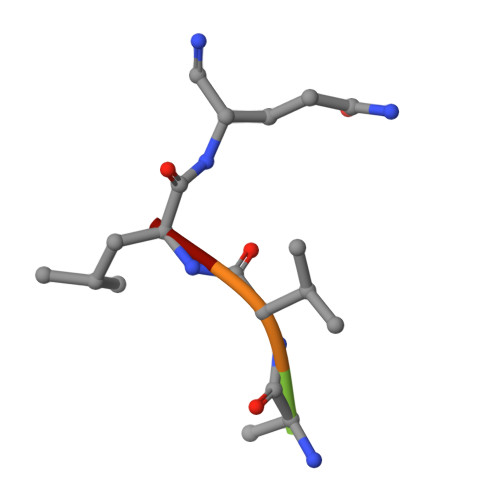Design, synthesis and crystallographic analysis of nitrile-based broad-spectrum peptidomimetic inhibitors for coronavirus 3C-like proteases
Chuck, C.P., Chen, C., Ke, Z., Wan, D.C.-C., Chow, H.F., Wong, K.B.(2012) Eur J Med Chem 59C: 1-6
- PubMed: 23202846
- DOI: https://doi.org/10.1016/j.ejmech.2012.10.053
- Primary Citation of Related Structures:
3VB3, 3VB4, 3VB5, 3VB6, 3VB7 - PubMed Abstract:
Coronaviral infection is associated with up to 5% of respiratory tract diseases. The 3C-like protease (3CL(pro)) of coronaviruses is required for proteolytic processing of polyproteins and viral replication, and is a promising target for the development of drugs against coronaviral infection. We designed and synthesized four nitrile-based peptidomimetic inhibitors with different N-terminal protective groups and different peptide length, and examined their inhibitory effect on the in-vitro enzymatic activity of 3CL(pro) of severe-acute-respiratory-syndrome-coronavirus. The IC(50) values of the inhibitors were in the range of 4.6-49 μM, demonstrating that the nitrile warhead can effectively inactivate the 3CL(pro) autocleavage process. The best inhibitor, Cbz-AVLQ-CN with an N-terminal carbobenzyloxy group, was ~10x more potent than the other inhibitors tested. Crystal structures of the enzyme-inhibitor complexes showed that the nitrile warhead inhibits 3CL(pro) by forming a covalent bond with the catalytic Cys145 residue, while the AVLQ peptide forms a number of favourable interactions with the S1-S4 substrate-binding pockets. We have further showed that the peptidomimetic inhibitor, Cbz-AVLQ-CN, has broad-spectrum inhibition against 3CL(pro) from human coronavirus strains 229E, NL63, OC43, HKU1, and infectious bronchitis virus, with IC(50) values ranging from 1.3 to 3.7 μM, but no detectable inhibition against caspase-3. In summary, we have shown that the nitrile-based peptidomimetic inhibitors are effective against 3CL(pro), and they inhibit 3CL(pro) from a broad range of coronaviruses. Our results provide further insights into the future design of drugs that could serve as a first line defence against coronaviral infection.
Organizational Affiliation:
School of Life Sciences and Center for Protein Science and Crystallography, The Chinese University of Hong Kong, Shatin, Hong Kong.


















